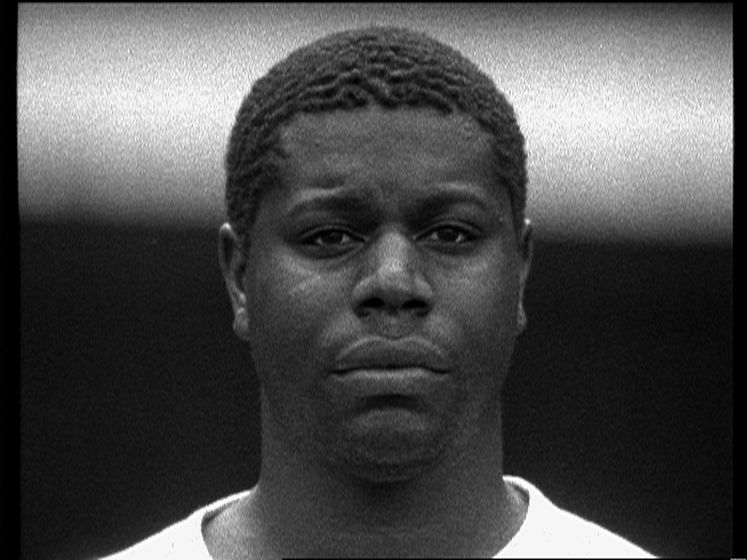 | British Nationality Born in 1969 in London (United Kingdom of Great Britain and Northern Ireland) Lives and works in London (United Kingdom ) | Biographie Bibliographie Liste expositions |
 | British Nationality Born in 1969 in London (United Kingdom of Great Britain and Northern Ireland) Lives and works in London (United Kingdom ) | Biographie Bibliographie Liste expositions |
Between 1989 and 1993, Steve McQueen studied in London at the Chelsea School of Art and Design and then Goldsmith College, where he became interested in film. Deciding to become a filmmaker, he went to study at New York University’s Tisch School of the Arts but stayed only one year: ‘I'd gone there because Spike Lee and Jim Jarmusch and Scorsese were there, but in fact it was just full of rich kids.’ His approach to film was already much more experimental than what his professors were recommending: ‘They wouldn't let you throw the camera up in the air’, he later recalled in one of his interviews. [1]
This was the period when he made his first film, Bear, which was only screened publicly two years later, in 1995. By that time, he had fled both the New York and London art worlds for Amsterdam, where he has lived since 1994.
Because of his itinerary between visual arts and film, and because he is attracted by both without fully recognising himself in one or the other, McQueen’s work lies at the crossroads of these two forms of creation. His films are not constructed on a traditional narrative model but rather, attempt to present a single event or moment. Among the references he cites for his exploration of filmic language and conventions are the French New Wave, Andy Warhol, Eisenstein and Orson Welles.
McQueen’s early films – Bear (1993), Five Easy Pieces (1995), Just Above My Head
(1996) and Stage (1996) – were shot in 16 or 32 mm, in black and white and without sound. These works, where the artist is always present, are characterised by their minimalism and extreme visual economy. With regard to the silence reigning in them, McQueen explains: ‘The whole idea of making it a silent piece is so that when people walk into the space they become very much aware of themselves, of their own breathing. . . . I want to put people into a situation where they are sensitive to themselves watching the piece.’ [2]
In 1997, he presented Catch (1997) at Dokumenta X; this unending descent into a diamond mine in South Africa was filmed in real time alongside the workers in the elevator [3]. A year later, he received a DAAD artist-in-residence grant to work in Berlin, where he exhibited a series of photographs entitled ‘Barrage’ (the French word for ‘dam’ or ‘obstacle’), which was entirely devoted to the rolls of cloth or carpet used to block or redirect the water in Paris gutters.
In 1999, McQueen was awarded the Tate Gallery’s Turner Prize for Deadpan and Drumroll, two video installations. Deadpan is a silent black-and-white film transferred onto video where he re-enacts Buster Keaton’s famous burlesque scene, while Drumroll was shot with three cameras mounted inside an oil drum which he rolled through the streets of Manhattan.
Over the past decade, he has continuously expanded the scope of his work and diversified the media he uses. He had already introduced sculpture with the White Elephant he showed at the entrance to his 1998 exhibition at the Institute of Contemporary Art in London; the following year, he added slides to his installation Girls, Tricky at the Zurich Kunsthalle. At that time, his films also became much less minimalist, with the use of colour and sound, as in Drumroll (1998), Prey (1999), Girls, Tricky (2001), Once Upon a Time (2002) and Western Deep/Carib’s Leap (2002).
In a 2003 article in Le Monde, art critic Geneviève Breerette wrote of McQueen’s work: ‘The fifteen or so films he has made over the past decade, lasting from a few seconds or minutes to less than half an hour, address all kinds of seemingly unrelated realities. They are like ever-more-intense probes at the edge of chasms where nothing can be measured any longer in known terms. One does not forget them. However yog he is (age 33), Steve McQueen has visual and intellectual arguments whose effectiveness stems from the economy of the means he brings into play to constitute meaning, and the physical impact of the images he produces: their grain, their proximity, that view from within which cancels out the screen and the distance between subject and viewer.’ [4]
Emilie Benoit
Translation Miriam Rosen
[1] BBC News, December 1st, 1999 : http://news.bbc.co.uk/1/hi/uk/544419.stm
[2] 'Let's Get Physical', interview with Patricia Bickers, Art Monthly, no. 202, December 1996-January 1997, p.2.
[3] On this work, see Geneviève Breerette, ‘Steve McQueen, l’humanité saisie à coups de sonde’, Le Monde (Paris), 10 February 2003.
[4] Ibid.